Manhood: The Rise and Fall of the Penis (46 page)
Read Manhood: The Rise and Fall of the Penis Online
Authors: Mels van Driel
Tags: #Medical, #Science, #History, #Nonfiction, #Psychology

ing. There is an important linguistic distinction between masturbation and onanism. For the reader not brought up with the language of the 242
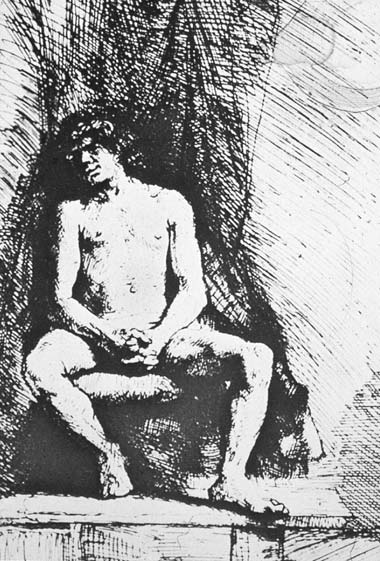
s p i l l i n g o n e ’ s s e e d
Rembrandt van
Rijn,
Seated Male
Nude
, 1646.
Bible, the term onanism is quite wrongly derived from Onan, a grand-son of the patriarch Jacob. In accordance with ancient Jewish custom Onan’s father demanded that he marry Tamar, the widow of his dead brother and have children with her. Onan did not want to do this and so ‘it came to pass, when he went in unto his brother’s wife, that he spilled [his seed] upon the ground, lest that he should give seed to his brother’ (Genesis 38:1–30). What Onan did is more accurately known as coitus interruptus.
243
m a n h o o d
Down to the nineteenth century
In the Middle Ages the Catholic church issued a long list of prohibitions in which all sins were described and assigned an appropriate penance.
Masturbation scored high on this list, though the penalty imposed depended on age and marital and religious status. In the seventeenth century science adopted the conclusions of the church virtually without question, assuming that the punishment would manifest itself in disease, madness or death. One of the first alarmists was the Swiss doctor Samuel-Auguste Tissot. He regarded masturbation as a crime and an act of suicide. Haemorrhoids, constipation, epilepsy, tuberculosis, paralysis and deformed children were all consequences of this crime.
One of his solutions was to sever the nerves in the penis. He wrote an academic thesis on the subject (
Traité de l’Onanisme: Dissertation sur
les Maladies produites par la Masturbation
), which appeared in Latin in 1760 and in French in 1764. Unusually for a thesis, it became a bestseller, and is predictably full of amusing exaggerations.
Tissot’s imitators were to make the list of symptoms and ailments caused by masturbation well-nigh endless. Various types of eye disease, headache above the eye sockets, pain at the back of the head, strange feelings above one’s head, various types of neuralgia, tenderness of the skin about the lowest part of the spine, asthma, heart murmur, blisters on wounds, acne, dilated pupils, squinting, bags under the eyes, intermittent deafness, pale and discoloured skin, redness of the nose, rack-ing coughs, urinary incontinence, warts on the hands, a strange smell on the skin – according to the doctors these were all the result of masturbation.
In 1818 the surgeon Jalade-Lafond designed a corset for the penis.
It reached from the shoulders down to the knees. Later different kinds of equipment appeared, including a metal tube which hung from a leather waistcoat, designed by the German Johann Fleck. An English invention perfected the German version: another metal tube was added to allow the user to urinate. The British were also responsible for naming the new diseases:
spermatorrhoia
or sexual neurasthenia. The English sexologist Havelock Ellis observed that for a highly sexed young man there was nothing for it but to enter a monastery. He devotes forty pages to this in
The Development of Morality
, which he wrote in 1897. He looks in detail at the studies published hitherto on what percentage of young men masturbated:
Brockman, also in America, among 232 theological students, of the average age of 23½ years and coming from various parts of the United States, found that 132 spontaneously admitted that 244
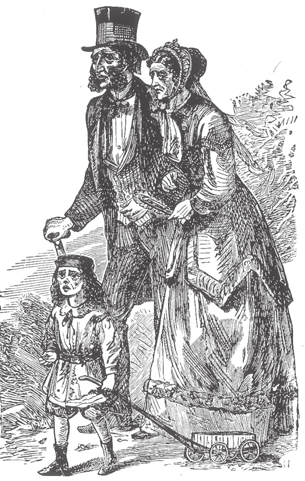
s p i l l i n g o n e ’ s s e e d
masturbation was their most serious temptation and all but one of these admitted that he yielded, 69 of them to a considerable extent. This is a proportion of at least 56 per cent, the real proportion being doubtless larger, since no question had been asked as to sexual offences; 75 practiced masturbation after conversion . . .
At the end of the nineteenth century doctors believed that self-abuse, the spilling of sperm, led not only to impotence but to general debilitation. A physician wrote at the time:
The onanist is unable to perform intercourse, his member having lost the necessary resilience, the capacity to become erect.
Victims of
onanism.
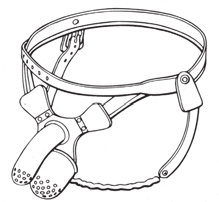
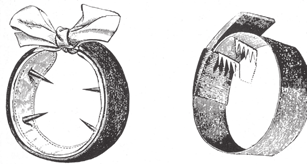
m a n h o o d
The noble juice, his male worth, his beauty has been lost. The source from which energy, mental power, courage and pride, talent and joy sprang has dried up, it has all been recklessly spilled; perhaps a little is left, but that little is thin, watery, powerless and moreover flows from him too soon.
Underlying this kind of thinking was a theory of scarcity. This theory springs from the atavistic notion that sperm derived directly from the spinal cord. Even Leonardo da Vinci had pictured it in this way, and consequently had drawn two drainage channels in the penis, one for sperm and one for urine.
In those days, to protect boys from an erection and onanism a ring was slid over the penis before bedtime. Previously a similar device had been designed for breeding stallions. Horse breeders had always known that breeding stallions tend to self-gratification instead of waiting for a willing mare. It was a time when no deep-frozen sperm could be stored in sperm banks. Because it was thought that excessive masturbation would be to the detriment of sperm quality, a kind of net was hung over the penis, so that when the animal had an erection a bell Apparatus for
preventing noc-
turnal erections.
s p i l l i n g o n e ’ s s e e d
rang and the horse breeder could intervene urgently. The devices sold well, at eight dollars apiece, a considerable sum at that time.
William Alexander Hammond (1828–1900) a surgeon and later professor of nervous and mental diseases at New York, was also convinced that self-gratification, particularly at a young age, was the principal cause of failure to achieve an erection. In the second chapter of his book
Sexual Impotence in the Male and Female
(1887) he takes over a hundred pages to explain what he sees as the root of the problem. Organs must be ‘mature’ before they are put under pressure. If a child is forced to study too young, it is in serious danger of developing epilepsy or becoming an idiot. If exposed to over-strenuous physical work the child’s growth will be stunted and it will remain backward and weak. For this reason Hammond is convinced that stimulation of the sex organs at an immature age leads to impotence.
As a salutary warning the professor tells the story of a young shepherd who gives himself over to onanism at a young age. Eventually the whole thing leads to gruesome complications, which are still observed in less serious form in contemporary urological practice.
Throughout, the shepherd has an aversion to women. He becomes melancholy and from then on is only concerned with satisfying his desires. One day he cuts a notch with a knife right through the glans in the direction of the urethra. This operation gives him a pleasant sensa -
tion and results in an abundant ejaculation. After having repeated this gruesome mutilation a number of times, the unfortunate shepherd realizes that he has divided his penis in two from the end of the urethra to the pubic bone. Hammond continues graphically:
When haemorrhage was particularly great, he arrested it by tying a cord around the penis. The corpora cavernosa, separated as they were, were equally capable of erection, but they diverged right and left. When the penis was divided as far as the symphysis, the knife was no longer useful . . .
New attempts and new disappointments follow:
Among the expedients to which he resorted was one with a piece of wood shorter than the one he had previously used, and which he introduced into the part of the urethra which remained to him. He thus succeeded in exciting the very orifices of the ejaculatory ducts and in causing an emission of semen.
For ten years this procedure satisfied him, until one day he was so careless in his use of his stick of wood that it escaped from his fingers and slipped into his bladder. At once he experienced 247
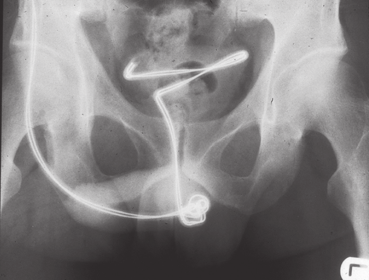
m a n h o o d
great pain, and all the efforts he made to expel the foreign body were without success. Finally after intense suffering from retention of urine and haemorrhage from the bladder, he consulted a surgeon, who was of course greatly astonished to find, instead of a single penis, two, each as large as the original. The great pain felt by the patient decided the surgeon to perform the operation of lithotomy, which having done he extracted the piece of wood – which from having been three months in the bladder was deeply encrusted with calcareous matter. After some serious drawbacks the patient recovered from the operation, but died about three months subsequently of phthisis, due to his long-continued and frequently repeated excesses.
After this anecdote you may think such things no longer happen. Well, every experienced urologist knows a patient who in solitude has tried to reach a climax by inserting an electric cord or something similar into the urethra. Usually such experiments end in a chilly operating theatre, because the cord in the urethra had started to twist.
A most unusual form of masturbation was described a few years back in a urological journal. A 40-year-old-man attended the A & E
department of a hospital in Pennsylvania. His scrotum was as big as a grapefruit. The left side had been torn open and the testicle was missing. The patient said that he had been injured at work a few days earlier. When questioned further, he admitted that while his fellow workers were at lunch, he had got into the habit of holding his erect x-ray photo of an
